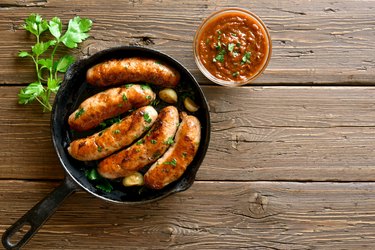
Germans are very serious about their sausage, and each region has their own version of bratwurst, or brats for short. The best way to cook brats may depend on whether you're preparing raw or precooked sausages. In either case, the stovetop works just fine.
Tip
To cook your brats on the stovetop, first parboil for about 20 minutes and then brown in a skillet over medium-high heat for 3 to 4 minutes.
Video of the Day
What Is Bratwurst?
Bratwurst is one of the many varieties of sausage that hail from Germany, which also includes the frankfurter and knockwurst. The brat is typically made from pork, veal, or beef, with some recipes using a mix of the different meats. Seasonings may vary depending on the recipe you're using and may include nutmeg, lemon or bacon, cheese, or peppers.
Video of the Day
If you're not up to making your bratwurst from scratch, you can find the German sausage at your local grocery store either fresh or precooked. Both fresh and precooked bratwurst can be prepared on the stove, with some slight variations in cooking times.
While the preparation may vary a bit between fresh and precooked brats, the USDA recommends you aim for an internal cooking temperature of 165 degrees Fahrenheit for both types. This is the ideal temperature for killing any potential pathogens that can lead to foodborne illness.
Read more: What is the Healthiest Meat?
Best Way to Cook Brats
Cooking bratwurst on the stovetop isn't difficult, but to get the best results you may require more than one pot. Because it's important to cook your fresh sausage thoroughly, the best way to cook these brats is to parboil them first and then finish them off in the skillet.
To parboil your bratwurst, place the sausages in a large pot and cover with enough water so the sausages are three-quarters covered. Place your pot on the stovetop and bring the water to a boil. Then turn the heat to simmer and cook the bratwurst for 20 minutes or until the sausages have reached an internal temperature of 165 degrees Fahrenheit.
While your brats are parboiling, heat a skillet over medium-high heat. Add your parboiled brats to the pan and cook covered 3 to 4 minutes per side.
Precooked brats don't have to be parboiled, but the National Hot Dog & Sausage Council suggests parboiling to reheat. The method for parboiling the precooked sausage is the same as fresh sausage, but check for doneness with your meat thermometer at the 10-minute mark and cook until the meat reaches the desired temperature. When your brats are ready for the stovetop, cook over medium-high heat covered, 3 to 4 minutes per side.
Read more: Is Pork Better Than Beef?
Tips for Cooking Bratwurst
When cooking bratwurst, consider altering the liquids during the parboil. Instead of water, use beer or broth. You can also add seasonings, such as garlic, onions, sage, oregano or rosemary, to the liquid to infuse more flavor.
To prevent your brats from splitting while you brown the casing, be sure to dry off the sausage before cooking brats in skillet. You can also dust the brats with flour to help absorb any excess moisture.
Beer not only makes a good liquid for parboiling but can also improve the browning of the brats. Brush the sausages with beer before placing them in the hot skillet. Dusting your brats with sugar has the same effect if you're looking for an alternative to beer.
After cooking bratwurst, there are an endless number of ways you can serve the tasty sausages. Consider putting them in buns covered with sauerkraut and mustard, or enjoy them with a side of German potato salad and steamed green beans, without the bun. Many Germans also serve horseradish with their bratwurst for some kick.
Not for Daily Consumption
Like other types of sausage, bratwurst is high in saturated fat and sodium. According to the nutrient data from the USDA one bun-size bratwurst (75 grams) has 250 calories, 10 grams of protein, 22 grams of fat, 7.5 grams of saturated fat and 634 milligrams of sodium.
According to the American Heart Association, you should limit your saturated fat intake to no more than 13 grams a day on a 2,000-calorie diet and sodium to 2,300 milligrams or less a day. Bratwurst is acceptable on occasion, but when it comes to heart-health, other proteins, such as chicken and fish, make better choices.
Plus, eating too much processed meat may increase your risk of chronic disease and shorten your lifespan, according to Harvard T.H. School of Public Health. While research has been mixed on the health consequences of processed meats, Harvard suggests you limit your intake of foods like bratwurst to small amounts once or twice a month.
- German Foods: "Guide to German Food"
- USDA Food Safety and Inspection Service: "Sausages and Food Safety"
- USDA: "Leftovers and Food Safety"
- National Hot Dog & Sausage Council: "Tips for Cooking Linked Sausage"
- FoodData Central: "Bratwurst"
- American Heart Association: "Saturated Fat"
- American Heart Association: "How Much Sodium Should I Eat Per Day?"
- Harvard T.H. School of Public Health: "Are All Processed Meats Equally Bad for Health?"
- Heart Research Funding: "Difference Between Bratwurst and Sausage"